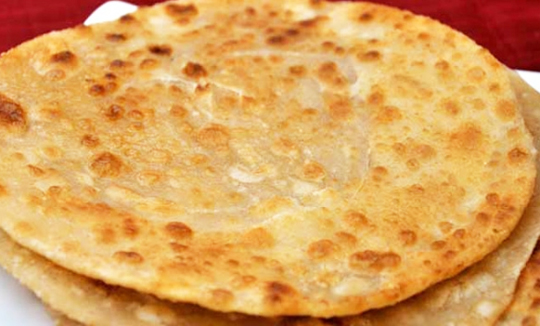Mama’s Punjabi Recipes: Chinni Da Parantha (Punjabi Crispy Sugar Flatbread)
What makes Punjabi paranthas (crispy flatbread) so tasty and popular with everyone who tries them are a few important features: they have to be served hot; they have to be thicker than plain Punjabi rotis; they must be slightly crispy on the top side and they must be coated with a small dab of ghee (clarified butter) or oil.
When you have mastered the cooking part of the parantha, then you can confidently try different types of fillings for paranthas, and you will begin to understand how long you must cook each, based on the different stuffings. Of course, you need a willing person who will try your paranthas and give you good feedback!
When my children were young and we lived in London, especially during the very cold months, they would really enjoy hot paranthas, but they were always looking for something different. They loved the gobi and aloo paranhas, but since they were growing up in the West, I experimented with their favorite Cheddar cheese to make paranthas. And, being children, they really loved the chinni (sugar) da parantha or the gur (jiggery) parantha which is more common.
The filling for the chinni parantha is very simple and because the sugar will melt when it is heated on the tava (flatplate), it is made slightly differently. Instead of rolling out a dough ball and then placing the stuffing in the center and re-rolling it; the chinni parantha is actually two separate rolled out pieces of dough; one slightly larger than the other.
Most paranthas are eaten with other dishes or plain dahin (yogurt); but the chinni parantha is more like a dessert to be eaten after a meal, just dipping into the melted sugar. Sometimes people will eat it with malai (clotted cream) or with a hot cup of milk.
Ingredients :
500gm kanak (gehon) ka atta (wheat flour)
½ cup chinni (sugar – white granulated or brown)
2 tbsp tael (olive oil or vegetable oil)
1 1/2 cups pani (water)
Directions:
1. Pour the flour into the bowl, then slowly pour only enough of the water in while kneading the dough till it becomes a nice, round, tender firm ball.
2. Dab the surface of the dough ball with a little water to keep it moist, cover the bowl and set aside for 10 minutes.
3. Pinch off a portion of the dough and make into a 2 inch round ball. Pour a little dry flour on the counter and roll the ball in it to coat it. Now use a velna (rolling pin) to roll the ball into a nice round, flat pancake, about 1/8 inch thick.
4. Take another dough ball and roll it out till it is at least ¼ inch wider than the previous one. Now spread a tablespoon of sugar over the whole pancake.
5. Place the smaller pancake on top and then take the edges of the larger one and fold then over the top one, pressing slightly to hold them together.
6. Place a tava (flat plate or flat skillet) on the stove, heat on medium and spread a dab of oil on it to coat it. Now carefully place the two pancakes on the tava and spread a dab of oil around the circumference on the tava.
7. Turn the heat to medium low and cook some more so that the sugar melts. When small brown spots appear, turn the parantha over and let it cook and use the oil again to let it become brown too. Do not turn the parantha too often.
8. Remove the parantha and serve while warm with malai (clotted cream), hot milk or by itself.
MAMA’S TIP OF THE WEEK
HOW TO CHOOSE THE RIGHT EGGPLANTS FOR A TASTY MEAL
People go shopping for vegetables and often are disappointed to find that their choices are not good; that the vegetables are too soft and bad inside or too hard and full of hard to chew seeds. When you begin to peel and cut them, you realize that you have to cut out too much and there is very little left to cook.
This is especially true of eggplants, whether the long Japanese ones, or the small Indian ones or the fat ones used for making bharta. The key to choosing eggplants is to make sure that they are not heavy, as this means that they have lots of seeds; and that their stems are green and not dry, wilted and brown, as this means they are old.
Shakuntla Malhotra is a skilled cook of Punjabi dishes made in the old-fashioned style that she learnt as a young woman in her ancestral home in Lyallpur, India before it became part of Pakistan after the Partition in 1947. People have often admired her cooking for its simplicity and taste that comes with each mouthful. Even in her mid-eighties, she continues to cook daily and agreed to share some of her delectable Punjabi recipes.


